| Listing 1 - 10 of 11 | << page >> |
Sort by
|
Book
ISBN: 1283227436 9786613227430 1400839041 9781400839049 9781283227438 9780691147949 0691147949 Year: 2012 Publisher: Princeton, N.J. : Princeton University Press,
Abstract | Keywords | Export | Availability | Bookmark
 Loading...
Loading...Choose an application
- Reference Manager
- EndNote
- RefWorks (Direct export to RefWorks)
"The study of the mapping class group Mod(S) is a classical topic that is experiencing a renaissance. It lies at the juncture of geometry, topology, and group theory. This book explains as many important theorems, examples, and techniques as possible, quickly and directly, while at the same time giving full details and keeping the text nearly self-contained. The book is suitable for graduate students.The book begins by explaining the main group-theoretical properties of Mod(S), from finite generation by Dehn twists and low-dimensional homology to the Dehn-Nielsen-Baer theorem. Along the way, central objects and tools are introduced, such as the Birman exact sequence, the complex of curves, the braid group, the symplectic representation, and the Torelli group. The book then introduces Teichm©oller space and its geometry, and uses the action of Mod(S) on it to prove the Nielsen-Thurston classification of surface homeomorphisms. Topics include the topology of the moduli space of Riemann surfaces, the connection with surface bundles, pseudo-Anosov theory, and Thurston's approach to the classification"--Provided by publisher.
Mappings (Mathematics) --- Class groups (Mathematics) --- Groups, Class (Mathematics) --- Algebraic number theory --- Commutative rings --- Ideals (Algebra) --- Maps (Mathematics) --- Functions --- Functions, Continuous --- Topology --- Transformations (Mathematics) --- 3-manifold theory. --- Alexander method. --- Birman exact sequence. --- BirmanЈilden theorem. --- Dehn twists. --- DehnЌickorish theorem. --- DehnЎielsenЂaer theorem. --- Dennis Johnson. --- Euler class. --- FenchelЎielsen coordinates. --- Gervais presentation. --- Grtzsch's problem. --- Johnson homomorphism. --- Markov partitions. --- Meyer signature cocycle. --- Mod(S). --- Nielsen realization theorem. --- NielsenДhurston classification theorem. --- NielsenДhurston classification. --- Riemann surface. --- Teichmller mapping. --- Teichmller metric. --- Teichmller space. --- Thurston compactification. --- Torelli group. --- Wajnryb presentation. --- algebraic integers. --- algebraic intersection number. --- algebraic relations. --- algebraic structure. --- annulus. --- aspherical manifold. --- bigon criterion. --- braid group. --- branched cover. --- capping homomorphism. --- classifying space. --- closed surface. --- collar lemma. --- compactness criterion. --- complex of curves. --- configuration space. --- conjugacy class. --- coordinates principle. --- cutting homomorphism. --- cyclic subgroup. --- diffeomorphism. --- disk. --- existence theorem. --- extended mapping class group. --- finite index. --- finite subgroup. --- finite-order homeomorphism. --- finite-order mapping class. --- first homology group. --- geodesic laminations. --- geometric classification. --- geometric group theory. --- geometric intersection number. --- geometric operation. --- geometry. --- harmonic maps. --- holomorphic quadratic differential. --- homeomorphism. --- homological criterion. --- homotopy. --- hyperbolic geometry. --- hyperbolic plane. --- hyperbolic structure. --- hyperbolic surface. --- inclusion homomorphism. --- infinity. --- intersection number. --- isotopy. --- lantern relation. --- low-dimensional homology. --- mapping class group. --- mapping torus. --- measured foliation space. --- measured foliations. --- metric geometry. --- moduli space. --- orbifold. --- orbit. --- outer automorphism group. --- pseudo-Anosov homeomorphism. --- punctured disk. --- quasi-isometry. --- quasiconformal map. --- second homology group. --- simple closed curve. --- simplicial complex. --- stretch factors. --- surface bundles. --- surface homeomorphism. --- surface. --- symplectic representation. --- topology. --- torsion. --- torus. --- train track.

ISBN: 0691085773 1306986230 0691602891 0691632340 1400861063 9780691085777 Year: 1990 Volume: 39 Publisher: Princeton (N.J.): Princeton university press,
Abstract | Keywords | Export | Availability | Bookmark
 Loading...
Loading...Choose an application
- Reference Manager
- EndNote
- RefWorks (Direct export to RefWorks)
One of the great achievements of contemporary mathematics is the new understanding of four dimensions. Michael Freedman and Frank Quinn have been the principals in the geometric and topological development of this subject, proving the Poincar and Annulus conjectures respectively. Recognition for this work includes the award of the Fields Medal of the International Congress of Mathematicians to Freedman in 1986. In Topology of 4-Manifolds these authors have collaborated to give a complete and accessible account of the current state of knowledge in this field. The basic material has been considerably simplified from the original publications, and should be accessible to most graduate students. The advanced material goes well beyond the literature; nearly one-third of the book is new. This work is indispensable for any topologist whose work includes four dimensions. It is a valuable reference for geometers and physicists who need an awareness of the topological side of the field.Originally published in 1990.The Princeton Legacy Library uses the latest print-on-demand technology to again make available previously out-of-print books from the distinguished backlist of Princeton University Press. These editions preserve the original texts of these important books while presenting them in durable paperback and hardcover editions. The goal of the Princeton Legacy Library is to vastly increase access to the rich scholarly heritage found in the thousands of books published by Princeton University Press since its founding in 1905.
Differential topology --- Four-manifolds (Topology) --- Trois-variétés (Topologie) --- Vier-menigvuldigheden (Topologie) --- 4-dimensional manifolds (Topology) --- 4-manifolds (Topology) --- Four dimensional manifolds (Topology) --- Manifolds, Four dimensional --- Low-dimensional topology --- Topological manifolds --- 4-manifold. --- Ambient isotopy. --- Annulus theorem. --- Automorphism. --- Baire category theorem. --- Bilinear form. --- Boundary (topology). --- CW complex. --- Category of manifolds. --- Central series. --- Characterization (mathematics). --- Cohomology. --- Commutative diagram. --- Commutative property. --- Commutator subgroup. --- Compactification (mathematics). --- Conformal geometry. --- Connected sum. --- Connectivity (graph theory). --- Cyclic group. --- Diagram (category theory). --- Diameter. --- Diffeomorphism. --- Differentiable manifold. --- Differential geometry. --- Dimension. --- Disk (mathematics). --- Duality (mathematics). --- Eigenvalues and eigenvectors. --- Embedding problem. --- Embedding. --- Equivariant map. --- Fiber bundle. --- Four-dimensional space. --- Fundamental group. --- General position. --- Geometry. --- H-cobordism. --- Handlebody. --- Hauptvermutung. --- Homeomorphism. --- Homology (mathematics). --- Homology sphere. --- Homomorphism. --- Homotopy group. --- Homotopy sphere. --- Homotopy. --- Hurewicz theorem. --- Hyperbolic geometry. --- Hyperbolic group. --- Hyperbolic manifold. --- Identity matrix. --- Intermediate value theorem. --- Intersection (set theory). --- Intersection curve. --- Intersection form (4-manifold). --- Intersection number (graph theory). --- Intersection number. --- J-homomorphism. --- Knot theory. --- Lefschetz duality. --- Line–line intersection. --- Manifold. --- Mapping cylinder. --- Mathematical induction. --- Metric space. --- Metrization theorem. --- Module (mathematics). --- Normal bundle. --- Parametrization. --- Parity (mathematics). --- Product topology. --- Pullback (differential geometry). --- Regular homotopy. --- Ring homomorphism. --- Rotation number. --- Seifert–van Kampen theorem. --- Sesquilinear form. --- Set (mathematics). --- Simply connected space. --- Smooth structure. --- Special case. --- Spin structure. --- Submanifold. --- Subset. --- Support (mathematics). --- Tangent bundle. --- Tangent space. --- Tensor product. --- Theorem. --- Topological category. --- Topological manifold. --- Transversal (geometry). --- Transversality (mathematics). --- Transversality theorem. --- Uniqueness theorem. --- Unit disk. --- Vector bundle. --- Whitehead torsion. --- Whitney disk.
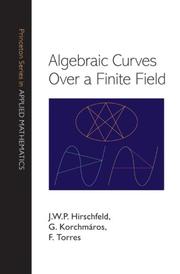
ISBN: 1400847419 9781400847419 1306988608 9781306988605 9781400847426 1400847427 0691096791 9780691096797 9780691096797 Year: 2008 Publisher: Princeton, New Jersey : Princeton University Press,
Abstract | Keywords | Export | Availability | Bookmark
 Loading...
Loading...Choose an application
- Reference Manager
- EndNote
- RefWorks (Direct export to RefWorks)
This book provides an accessible and self-contained introduction to the theory of algebraic curves over a finite field, a subject that has been of fundamental importance to mathematics for many years and that has essential applications in areas such as finite geometry, number theory, error-correcting codes, and cryptology. Unlike other books, this one emphasizes the algebraic geometry rather than the function field approach to algebraic curves. The authors begin by developing the general theory of curves over any field, highlighting peculiarities occurring for positive characteristic and requiring of the reader only basic knowledge of algebra and geometry. The special properties that a curve over a finite field can have are then discussed. The geometrical theory of linear series is used to find estimates for the number of rational points on a curve, following the theory of Stöhr and Voloch. The approach of Hasse and Weil via zeta functions is explained, and then attention turns to more advanced results: a state-of-the-art introduction to maximal curves over finite fields is provided; a comprehensive account is given of the automorphism group of a curve; and some applications to coding theory and finite geometry are described. The book includes many examples and exercises. It is an indispensable resource for researchers and the ideal textbook for graduate students.
Curves, Algebraic. --- Finite fields (Algebra) --- Modular fields (Algebra) --- Algebra, Abstract --- Algebraic fields --- Galois theory --- Modules (Algebra) --- Algebraic curves --- Algebraic varieties --- Abelian group. --- Abelian variety. --- Affine plane. --- Affine space. --- Affine variety. --- Algebraic closure. --- Algebraic curve. --- Algebraic equation. --- Algebraic extension. --- Algebraic function. --- Algebraic geometry. --- Algebraic integer. --- Algebraic number field. --- Algebraic number theory. --- Algebraic number. --- Algebraic variety. --- Algebraically closed field. --- Applied mathematics. --- Automorphism. --- Birational invariant. --- Characteristic exponent. --- Classification theorem. --- Clifford's theorem. --- Combinatorics. --- Complex number. --- Computation. --- Cyclic group. --- Cyclotomic polynomial. --- Degeneracy (mathematics). --- Degenerate conic. --- Divisor (algebraic geometry). --- Divisor. --- Dual curve. --- Dual space. --- Elliptic curve. --- Equation. --- Fermat curve. --- Finite field. --- Finite geometry. --- Finite group. --- Formal power series. --- Function (mathematics). --- Function field. --- Fundamental theorem. --- Galois extension. --- Galois theory. --- Gauss map. --- General position. --- Generic point. --- Geometry. --- Homogeneous polynomial. --- Hurwitz's theorem. --- Hyperelliptic curve. --- Hyperplane. --- Identity matrix. --- Inequality (mathematics). --- Intersection number (graph theory). --- Intersection number. --- J-invariant. --- Line at infinity. --- Linear algebra. --- Linear map. --- Mathematical induction. --- Mathematics. --- Menelaus' theorem. --- Modular curve. --- Natural number. --- Number theory. --- Parity (mathematics). --- Permutation group. --- Plane curve. --- Point at infinity. --- Polar curve. --- Polygon. --- Polynomial. --- Power series. --- Prime number. --- Projective plane. --- Projective space. --- Quadratic transformation. --- Quadric. --- Resolution of singularities. --- Riemann hypothesis. --- Scalar multiplication. --- Scientific notation. --- Separable extension. --- Separable polynomial. --- Sign (mathematics). --- Singular point of a curve. --- Special case. --- Subgroup. --- Sylow theorems. --- System of linear equations. --- Tangent. --- Theorem. --- Transcendence degree. --- Upper and lower bounds. --- Valuation ring. --- Variable (mathematics). --- Vector space.
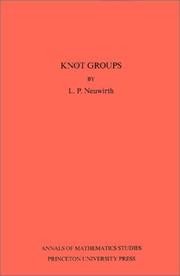
ISBN: 0691079919 1400882036 9780691079912 Year: 1965 Volume: 56 Publisher: Princeton (N.J.): Princeton university press,
Abstract | Keywords | Export | Availability | Bookmark
 Loading...
Loading...Choose an application
- Reference Manager
- EndNote
- RefWorks (Direct export to RefWorks)
The description for this book, Knot Groups. Annals of Mathematics Studies. (AM-56), Volume 56, will be forthcoming.
Topology --- 512 --- Algebra --- 512 Algebra --- Knot theory. --- Knots (Topology) --- Low-dimensional topology --- Abelian group. --- Alexander duality. --- Alexander polynomial. --- Algebraic theory. --- Algorithm. --- Analytic continuation. --- Associative property. --- Automorphism. --- Axiom. --- Bijection. --- Binary relation. --- Calculation. --- Central series. --- Characterization (mathematics). --- Cobordism. --- Coefficient. --- Cohomology. --- Combinatorics. --- Commutator subgroup. --- Complete theory. --- Computation. --- Conjugacy class. --- Conjugate element (field theory). --- Connected space. --- Connectedness. --- Coprime integers. --- Coset. --- Covering space. --- Curve. --- Cyclic group. --- Dehn's lemma. --- Determinant. --- Diagonalization. --- Diagram (category theory). --- Dimension. --- Direct product. --- Equivalence class. --- Equivalence relation. --- Euclidean space. --- Euler characteristic. --- Existential quantification. --- Fiber bundle. --- Finite group. --- Finitely generated module. --- Frattini subgroup. --- Free abelian group. --- Fundamental group. --- Geometry. --- Group ring. --- Group theory. --- Group with operators. --- Hausdorff space. --- Homeomorphism. --- Homology (mathematics). --- Homomorphism. --- Homotopy group. --- Homotopy. --- Identity matrix. --- Inner automorphism. --- Interior (topology). --- Intersection number (graph theory). --- Knot group. --- Linear combination. --- Manifold. --- Mathematical induction. --- Monomorphism. --- Morphism. --- Morse theory. --- Natural transformation. --- Non-abelian group. --- Normal subgroup. --- Orientability. --- Permutation. --- Polynomial. --- Presentation of a group. --- Principal ideal domain. --- Principal ideal. --- Root of unity. --- Semigroup. --- Simplicial complex. --- Simply connected space. --- Special case. --- Square matrix. --- Subgroup. --- Subset. --- Summation. --- Theorem. --- Three-dimensional space (mathematics). --- Topological space. --- Topology. --- Torus knot. --- Transfinite number. --- Trefoil knot. --- Trichotomy (mathematics). --- Trivial group. --- Triviality (mathematics). --- Two-dimensional space. --- Unit vector. --- Wreath product.

ISBN: 069108081X 9781400822492 1400822491 9780691080819 Year: 1971 Volume: 66 Publisher: Princeton (N.J.) : Princeton university press,
Abstract | Keywords | Export | Availability | Bookmark
 Loading...
Loading...Choose an application
- Reference Manager
- EndNote
- RefWorks (Direct export to RefWorks)
Intended for researchers in Riemann surfaces, this volume summarizes a significant portion of the work done in the field during the years 1966 to 1971.
Riemann surfaces --- Mathematics --- Physical Sciences & Mathematics --- Calculus --- Surfaces, Riemann --- Functions --- Congresses --- Differential geometry. Global analysis --- RIEMANN SURFACES --- congresses --- Congresses. --- MATHEMATICS / Calculus. --- Affine space. --- Algebraic function field. --- Algebraic structure. --- Analytic continuation. --- Analytic function. --- Analytic set. --- Automorphic form. --- Automorphic function. --- Automorphism. --- Beltrami equation. --- Bernhard Riemann. --- Boundary (topology). --- Canonical basis. --- Cartesian product. --- Clifford's theorem. --- Cohomology. --- Commutative diagram. --- Commutative property. --- Complex multiplication. --- Conformal geometry. --- Conformal map. --- Coset. --- Degeneracy (mathematics). --- Diagram (category theory). --- Differential geometry of surfaces. --- Dimension (vector space). --- Dirichlet boundary condition. --- Eigenfunction. --- Eigenvalues and eigenvectors. --- Eisenstein series. --- Euclidean space. --- Existential quantification. --- Explicit formulae (L-function). --- Exterior (topology). --- Finsler manifold. --- Fourier series. --- Fuchsian group. --- Function (mathematics). --- Generating set of a group. --- Group (mathematics). --- Hilbert space. --- Holomorphic function. --- Homeomorphism. --- Homology (mathematics). --- Homotopy. --- Hyperbolic geometry. --- Hyperbolic group. --- Identity matrix. --- Infimum and supremum. --- Inner automorphism. --- Intersection (set theory). --- Intersection number (graph theory). --- Isometry. --- Isomorphism class. --- Isomorphism theorem. --- Kleinian group. --- Limit point. --- Limit set. --- Linear map. --- Lorentz group. --- Mapping class group. --- Mathematical induction. --- Mathematics. --- Matrix (mathematics). --- Matrix multiplication. --- Measure (mathematics). --- Meromorphic function. --- Metric space. --- Modular group. --- Möbius transformation. --- Number theory. --- Osgood curve. --- Parity (mathematics). --- Partial isometry. --- Poisson summation formula. --- Pole (complex analysis). --- Projective space. --- Quadratic differential. --- Quadratic form. --- Quasiconformal mapping. --- Quotient space (linear algebra). --- Quotient space (topology). --- Riemann mapping theorem. --- Riemann sphere. --- Riemann surface. --- Riemann zeta function. --- Scalar multiplication. --- Scientific notation. --- Selberg trace formula. --- Series expansion. --- Sign (mathematics). --- Square-integrable function. --- Subgroup. --- Teichmüller space. --- Theorem. --- Topological manifold. --- Topological space. --- Uniformization. --- Unit disk. --- Variable (mathematics). --- Riemann, Surfaces de --- RIEMANN SURFACES - congresses --- Fonctions d'une variable complexe --- Surfaces de riemann
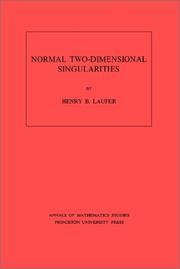
ISBN: 069108100X 1400881749 9780691081007 Year: 1971 Volume: 71 Publisher: Princeton (N.J.): Princeton university press,
Abstract | Keywords | Export | Availability | Bookmark
 Loading...
Loading...Choose an application
- Reference Manager
- EndNote
- RefWorks (Direct export to RefWorks)
A survey, thorough and timely, of the singularities of two-dimensional normal complex analytic varieties, the volume summarizes the results obtained since Hirzebruch's thesis (1953) and presents new contributions. First, the singularity is resolved and shown to be classified by its resolution; then, resolutions are classed by the use of spaces with nilpotents; finally, the spaces with nilpotents are determined by means of the local ring structure of the singularity.
Algebraic geometry --- Analytic spaces --- SINGULARITIES (Mathematics) --- 512.76 --- Singularities (Mathematics) --- Geometry, Algebraic --- Spaces, Analytic --- Analytic functions --- Functions of several complex variables --- Birational geometry. Mappings etc. --- Analytic spaces. --- Singularities (Mathematics). --- 512.76 Birational geometry. Mappings etc. --- Birational geometry. Mappings etc --- Analytic function. --- Analytic set. --- Analytic space. --- Automorphism. --- Bernhard Riemann. --- Big O notation. --- Calculation. --- Chern class. --- Codimension. --- Coefficient. --- Cohomology. --- Compact Riemann surface. --- Complex manifold. --- Computation. --- Connected component (graph theory). --- Continuous function. --- Contradiction. --- Coordinate system. --- Corollary. --- Covering space. --- Dimension. --- Disjoint union. --- Divisor. --- Dual graph. --- Elliptic curve. --- Elliptic function. --- Embedding. --- Existential quantification. --- Factorization. --- Fiber bundle. --- Finite set. --- Formal power series. --- Hausdorff space. --- Holomorphic function. --- Homeomorphism. --- Homology (mathematics). --- Intersection (set theory). --- Intersection number (graph theory). --- Inverse limit. --- Irreducible component. --- Isolated singularity. --- Iteration. --- Lattice (group). --- Line bundle. --- Linear combination. --- Line–line intersection. --- Local coordinates. --- Local ring. --- Mathematical induction. --- Maximal ideal. --- Meromorphic function. --- Monic polynomial. --- Nilpotent. --- Normal bundle. --- Open set. --- Parameter. --- Plane curve. --- Pole (complex analysis). --- Power series. --- Presheaf (category theory). --- Projective line. --- Quadratic transformation. --- Quantity. --- Riemann surface. --- Riemann–Roch theorem. --- Several complex variables. --- Submanifold. --- Subset. --- Tangent bundle. --- Tangent space. --- Tensor algebra. --- Theorem. --- Topological space. --- Transition function. --- Two-dimensional space. --- Variable (mathematics). --- Zero divisor. --- Zero of a function. --- Zero set. --- Variétés complexes --- Espaces analytiques
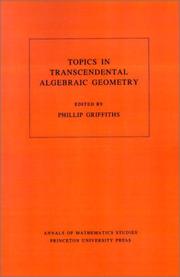
ISBN: 0691083355 0691083398 140088165X Year: 1984 Publisher: Princeton (N.J.) Princeton University Press
Abstract | Keywords | Export | Availability | Bookmark
 Loading...
Loading...Choose an application
- Reference Manager
- EndNote
- RefWorks (Direct export to RefWorks)
The description for this book, Topics in Transcendental Algebraic Geometry. (AM-106), Volume 106, will be forthcoming.
Geometry, Algebraic. --- Hodge theory. --- Torelli theorem. --- Géométrie algébrique --- Théorie de Hodge --- Geometry, Algebraic --- Hodge theory --- Torelli theorem --- 512.7 --- Torelli's theorem --- Curves, Algebraic --- Jacobians --- Complex manifolds --- Differentiable manifolds --- Homology theory --- Algebraic geometry --- Geometry --- Algebraic geometry. Commutative rings and algebras --- 512.7 Algebraic geometry. Commutative rings and algebras --- Géométrie algébrique --- Théorie de Hodge --- Abelian integral. --- Algebraic curve. --- Algebraic cycle. --- Algebraic equation. --- Algebraic geometry. --- Algebraic integer. --- Algebraic structure. --- Algebraic surface. --- Arithmetic genus. --- Arithmetic group. --- Asymptotic analysis. --- Automorphism. --- Base change. --- Bilinear form. --- Bilinear map. --- Cohomology. --- Combinatorics. --- Commutative diagram. --- Compactification (mathematics). --- Complete intersection. --- Complex manifold. --- Complex number. --- Computation. --- Deformation theory. --- Degeneracy (mathematics). --- Differentiable manifold. --- Dimension (vector space). --- Divisor (algebraic geometry). --- Divisor. --- Elliptic curve. --- Elliptic surface. --- Equation. --- Exact sequence. --- Fiber bundle. --- Function (mathematics). --- Fundamental class. --- Geometric genus. --- Geometry. --- Hermitian symmetric space. --- Hodge structure. --- Homology (mathematics). --- Homomorphism. --- Homotopy. --- Hypersurface. --- Intersection form (4-manifold). --- Intersection number. --- Irreducibility (mathematics). --- Isomorphism class. --- Jacobian variety. --- K3 surface. --- Kodaira dimension. --- Kronecker's theorem. --- Kummer surface. --- Kähler manifold. --- Lie algebra bundle. --- Lie algebra. --- Linear algebra. --- Linear algebraic group. --- Line–line intersection. --- Mathematical induction. --- Mathematical proof. --- Mathematics. --- Modular arithmetic. --- Module (mathematics). --- Moduli space. --- Monodromy matrix. --- Monodromy theorem. --- Monodromy. --- Nilpotent orbit. --- Normal function. --- Open set. --- Period mapping. --- Permutation group. --- Phillip Griffiths. --- Point at infinity. --- Pole (complex analysis). --- Polynomial. --- Projective space. --- Pullback (category theory). --- Quadric. --- Regular singular point. --- Resolution of singularities. --- Riemann–Roch theorem for surfaces. --- Scientific notation. --- Set (mathematics). --- Special case. --- Spectral sequence. --- Subgroup. --- Submanifold. --- Surface of general type. --- Surjective function. --- Tangent bundle. --- Theorem. --- Topology. --- Transcendental number. --- Vector space. --- Zariski topology. --- Zariski's main theorem.
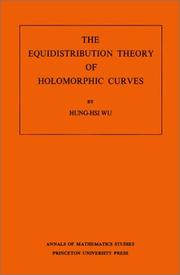
ISBN: 0691080739 1400881900 Year: 1970 Publisher: Tokyo : University of Tokyo press,
Abstract | Keywords | Export | Availability | Bookmark
 Loading...
Loading...Choose an application
- Reference Manager
- EndNote
- RefWorks (Direct export to RefWorks)
This work is a fresh presentation of the Ahlfors-Weyl theory of holomorphic curves that takes into account some recent developments in Nevanlinna theory and several complex variables. The treatment is differential geometric throughout, and assumes no previous acquaintance with the classical theory of Nevanlinna. The main emphasis is on holomorphic curves defined over Riemann surfaces, which admit a harmonic exhaustion, and the main theorems of the subject are proved for such surfaces. The author discusses several directions for further research.
Analytic functions. --- Functions, Meromorphic. --- Value distribution theory. --- Meromorphic functions --- Functions, Analytic --- Functions, Monogenic --- Functions, Regular --- Regular functions --- Functions of complex variables --- Series, Taylor's --- Distribution of values theory --- Functions, Entire --- Functions, Meromorphic --- Addition. --- Algebraic curve. --- Algebraic number. --- Atlas (topology). --- Binomial coefficient. --- Cauchy–Riemann equations. --- Compact Riemann surface. --- Compact space. --- Complex manifold. --- Complex projective space. --- Computation. --- Continuous function (set theory). --- Covariant derivative. --- Critical value. --- Curvature form. --- Diagram (category theory). --- Differential form. --- Differential geometry of surfaces. --- Differential geometry. --- Dimension. --- Divisor. --- Essential singularity. --- Euler characteristic. --- Existential quantification. --- Fiber bundle. --- Gaussian curvature. --- Geodesic curvature. --- Geometry. --- Grassmannian. --- Harmonic function. --- Hermann Weyl. --- Hermitian manifold. --- Holomorphic function. --- Homology (mathematics). --- Hyperbolic manifold. --- Hyperplane. --- Hypersurface. --- Improper integral. --- Intersection number (graph theory). --- Isometry. --- Line integral. --- Manifold. --- Meromorphic function. --- Minimal surface. --- Nevanlinna theory. --- One-form. --- Open problem. --- Open set. --- Orthogonal complement. --- Parameter. --- Picard theorem. --- Product metric. --- Q.E.D. --- Remainder. --- Riemann sphere. --- Riemann surface. --- Smoothness. --- Special case. --- Submanifold. --- Subset. --- Tangent space. --- Tangent. --- Theorem. --- Three-dimensional space (mathematics). --- Unit circle. --- Unit vector. --- Vector field. --- Volume element. --- Volume form. --- Fonctions de plusieurs variables complexes
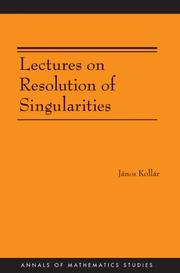
ISBN: 0691129231 0691129223 9786612157745 1282157744 1400827809 9781400827800 9780691129228 9780691129235 9781282157743 Year: 2007 Publisher: Princeton, N.J. : Princeton University Press,
Abstract | Keywords | Export | Availability | Bookmark
 Loading...
Loading...Choose an application
- Reference Manager
- EndNote
- RefWorks (Direct export to RefWorks)
Resolution of singularities is a powerful and frequently used tool in algebraic geometry. In this book, János Kollár provides a comprehensive treatment of the characteristic 0 case. He describes more than a dozen proofs for curves, many based on the original papers of Newton, Riemann, and Noether. Kollár goes back to the original sources and presents them in a modern context. He addresses three methods for surfaces, and gives a self-contained and entirely elementary proof of a strong and functorial resolution in all dimensions. Based on a series of lectures at Princeton University and written in an informal yet lucid style, this book is aimed at readers who are interested in both the historical roots of the modern methods and in a simple and transparent proof of this important theorem.
Singularities (Mathematics) --- 512.761 --- Geometry, Algebraic --- Singularities. Singular points of algebraic varieties --- 512.761 Singularities. Singular points of algebraic varieties --- Adjunction formula. --- Algebraic closure. --- Algebraic geometry. --- Algebraic space. --- Algebraic surface. --- Algebraic variety. --- Approximation. --- Asymptotic analysis. --- Automorphism. --- Bernhard Riemann. --- Big O notation. --- Birational geometry. --- C0. --- Canonical singularity. --- Codimension. --- Cohomology. --- Commutative algebra. --- Complex analysis. --- Complex manifold. --- Computability. --- Continuous function. --- Coordinate system. --- Diagram (category theory). --- Differential geometry of surfaces. --- Dimension. --- Divisor. --- Du Val singularity. --- Dual graph. --- Embedding. --- Equation. --- Equivalence relation. --- Euclidean algorithm. --- Factorization. --- Functor. --- General position. --- Generic point. --- Geometric genus. --- Geometry. --- Hyperplane. --- Hypersurface. --- Integral domain. --- Intersection (set theory). --- Intersection number (graph theory). --- Intersection theory. --- Irreducible component. --- Isolated singularity. --- Laurent series. --- Line bundle. --- Linear space (geometry). --- Linear subspace. --- Mathematical induction. --- Mathematics. --- Maximal ideal. --- Morphism. --- Newton polygon. --- Noetherian ring. --- Noetherian. --- Open problem. --- Open set. --- P-adic number. --- Pairwise. --- Parametric equation. --- Partial derivative. --- Plane curve. --- Polynomial. --- Power series. --- Principal ideal. --- Principalization (algebra). --- Projective space. --- Projective variety. --- Proper morphism. --- Puiseux series. --- Quasi-projective variety. --- Rational function. --- Regular local ring. --- Resolution of singularities. --- Riemann surface. --- Ring theory. --- Ruler. --- Scientific notation. --- Sheaf (mathematics). --- Singularity theory. --- Smooth morphism. --- Smoothness. --- Special case. --- Subring. --- Summation. --- Surjective function. --- Tangent cone. --- Tangent space. --- Tangent. --- Taylor series. --- Theorem. --- Topology. --- Toric variety. --- Transversal (geometry). --- Variable (mathematics). --- Weierstrass preparation theorem. --- Weierstrass theorem. --- Zero set. --- Differential geometry. Global analysis
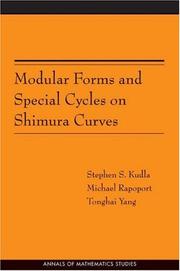
ISBN: 1299401023 1400837162 0691125511 0691125503 9781400837168 9780691125503 9780691125510 9781299401020 Year: 2006 Publisher: Princeton : Princeton University Press,
Abstract | Keywords | Export | Availability | Bookmark
 Loading...
Loading...Choose an application
- Reference Manager
- EndNote
- RefWorks (Direct export to RefWorks)
Modular Forms and Special Cycles on Shimura Curves is a thorough study of the generating functions constructed from special cycles, both divisors and zero-cycles, on the arithmetic surface "M" attached to a Shimura curve "M" over the field of rational numbers. These generating functions are shown to be the q-expansions of modular forms and Siegel modular forms of genus two respectively, valued in the Gillet-Soulé arithmetic Chow groups of "M". The two types of generating functions are related via an arithmetic inner product formula. In addition, an analogue of the classical Siegel-Weil formula identifies the generating function for zero-cycles as the central derivative of a Siegel Eisenstein series. As an application, an arithmetic analogue of the Shimura-Waldspurger correspondence is constructed, carrying holomorphic cusp forms of weight 3/2 to classes in the Mordell-Weil group of "M". In certain cases, the nonvanishing of this correspondence is related to the central derivative of the standard L-function for a modular form of weight 2. These results depend on a novel mixture of modular forms and arithmetic geometry and should provide a paradigm for further investigations. The proofs involve a wide range of techniques, including arithmetic intersection theory, the arithmetic adjunction formula, representation densities of quadratic forms, deformation theory of p-divisible groups, p-adic uniformization, the Weil representation, the local and global theta correspondence, and the doubling integral representation of L-functions.
Arithmetical algebraic geometry. --- Shimura varieties. --- Varieties, Shimura --- Algebraic geometry, Arithmetical --- Arithmetic algebraic geometry --- Diophantine geometry --- Geometry, Arithmetical algebraic --- Geometry, Diophantine --- Arithmetical algebraic geometry --- Number theory --- Abelian group. --- Addition. --- Adjunction formula. --- Algebraic number theory. --- Arakelov theory. --- Arithmetic. --- Automorphism. --- Bijection. --- Borel subgroup. --- Calculation. --- Chow group. --- Coefficient. --- Cohomology. --- Combinatorics. --- Compact Riemann surface. --- Complex multiplication. --- Complex number. --- Cup product. --- Deformation theory. --- Derivative. --- Dimension. --- Disjoint union. --- Divisor. --- Dual pair. --- Eigenfunction. --- Eigenvalues and eigenvectors. --- Eisenstein series. --- Elliptic curve. --- Endomorphism. --- Equation. --- Explicit formulae (L-function). --- Fields Institute. --- Formal group. --- Fourier series. --- Fundamental matrix (linear differential equation). --- Galois group. --- Generating function. --- Green's function. --- Group action. --- Induced representation. --- Intersection (set theory). --- Intersection number. --- Irreducible component. --- Isomorphism class. --- L-function. --- Laurent series. --- Level structure. --- Line bundle. --- Local ring. --- Mathematical sciences. --- Mathematics. --- Metaplectic group. --- Modular curve. --- Modular form. --- Modularity (networks). --- Moduli space. --- Multiple integral. --- Number theory. --- Numerical integration. --- Orbifold. --- Orthogonal complement. --- P-adic number. --- Pairing. --- Prime factor. --- Prime number. --- Pullback (category theory). --- Pullback (differential geometry). --- Pullback. --- Quadratic form. --- Quadratic residue. --- Quantity. --- Quaternion algebra. --- Quaternion. --- Quotient stack. --- Rational number. --- Real number. --- Residue field. --- Riemann zeta function. --- Ring of integers. --- SL2(R). --- Scientific notation. --- Shimura variety. --- Siegel Eisenstein series. --- Siegel modular form. --- Special case. --- Standard L-function. --- Subgroup. --- Subset. --- Summation. --- Tensor product. --- Test vector. --- Theorem. --- Three-dimensional space (mathematics). --- Topology. --- Trace (linear algebra). --- Triangular matrix. --- Two-dimensional space. --- Uniformization. --- Valuative criterion. --- Whittaker function.
| Listing 1 - 10 of 11 | << page >> |
Sort by
|

 Search
Search Feedback
Feedback About UniCat
About UniCat  Help
Help News
News